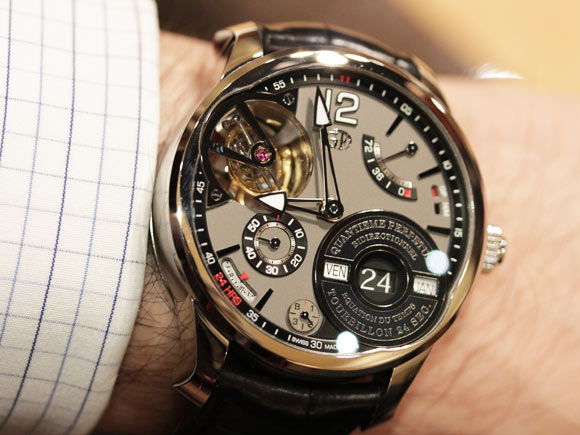David Chokron: Greubel Forsey is a tourbillon specialist. And you’re now launching a Perpetual Calendar. How long have you been working on this topic?
Stephen Greubel: Robert Greubel and I have taken an interest in calendars ever since 1999. We already worked on a large-sized Perpetual Calendar for a planetarium. In that instance we had no size-related restrictions, which meant we used solutions that cannot be incorporated within a wristwatch. It was however worthwhile, since it enabled us to get to grips with the area and to examine in considerable the detail the various challenges involved in the perpetual calendar. And we knew we wanted to come back to it.

What aspects required development?
When you look at existing perpetual calendars, there are basically three small apertures for the indications, spread around the dial. This is logical in that it’s a miniaturised version of the system initially devised for pocket watches. It is based on additional plate, which works very well. However, it works in one direction only, meaning that you can only move the date forwards, and the indications are also scattered rather than grouped. We decided that if we were to do something, it has to be of value to the user. As young watchmakers, we had seen watches returned for repair with calendar indications not working properly and which had to be manually adjusted, a process requiring a number of different operations. We wanted to make things easier for customers, who need to be able to enjoy the interaction with their watch as well as easy read-off. The system must be accessible, legible and always in the same place.
What does that imply in practical terms?
At the SIHH 2012, we had already introduced our EWT perpetual calendar project, stemming from our technical development platform. We worked on a coding system for the perpetual calendar that would make it useful to collectors. The indications are simple and synchronised. If the date is moved forwards via the crown, all the indications also move forwards. So far, so good. But if you want to go backwards, it becomes far more complex to control adjustments in both directions. Our goal was to be able to encode the day, the date, the month and the year.
So can one change the date at any time?
This model has an indicator of the periods when the date should not be adjusted, a new feature designed to ensure maximum user-friendliness.

“We knew we wanted to come back to the perpetual calendar”
What about the price tag?
670,000 Swiss francs. Considering the work involved, this calendar model is truly unique. There are only three bidirectional calendar models on the market and not one of them is pre-encoded. And in any case that’s not how we actually calculate things. To start with, there are 570 decorated parts. Moreover, many years of work, experience, verification and prototypes are required to achieve such a result. We could also have made a perpetual calendar with an additional plate, but this one is fully integrated within an all-new movement. It has a 24-second inclined tourbillon to ensure accurate running, but any comparisons with our other movements stop there. This one has a new going train, a new time-setting system and new barrels. The photo is of course not enough to help people understand the price. You have to dig a little deeper to grasp what lies behind it.
And the equation of time?
The equation of time indication has been around for ages. It uses a bean-shaped cam, but it does not provide any indication regarding the earth’s path around the sun. We have developed a new system displaying the moments when solar time and mean time meet up. Two superimposed transparent discs display the points of intersection as well as showing the equinoxes and solstices. This system thus provides a clearer indication of the earth’s irregular elliptical orbit around the sun.







